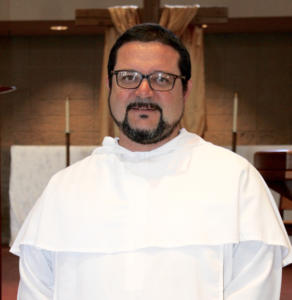 By Fr. Reginald, O.P.
By Fr. Reginald, O.P.
Note: If you read the paper version of the bulletin, you might have missed my last article on Gregorian Chant, as they were not delivered because of weather. If interested, you can read it online here: www.comonewman.org/the-sound-of-prayer. (If you are not technically savvy, you can perhaps ask your children or grandchildren to print it for you.)
This week, in the spirit of Lent, I would like to focus on another form of prayer, namely the practice of silence. Over the last year or so, I have been slowly reading through the book, The Power of Silence: Against the Dictatorship of Noise, by the Guinean Cardinal Robert Sarah, prefect of the Vatican’s Congregation for Worship. Although Sarah is a learned theologian and liturgist, this book is a very readable collection of observations on prayer and our need to quiet our minds in order to raise them to God, inspired by his time with a French monk on his deathbed. It was written through a conversation at the Grande Chartreuse, the head monastery of the great contemplative Carthusian Order. (The Grande Chartreuse was also the subject of an extraordinary 2005 documentary film, Into Great Silence. The film simply follows the life of the monks going about their daily routine: long periods of chanting their prayers, along with times of work and recreation. If you can find some undisturbed time to watch it, it feels like a 3-hour retreat.)
Our world today has so many noisy demands and so many technological ways that these demands and distractions can reach us. And, in the affluent West, we are used to having so many comforts at our disposal (you’ve heard of the cliche of First World Problems). Further, our busy world has convinced many that the meaning of life is found in some form of activity. All of these factors militate against the practice of contemplation and silence and threaten to obscure the truth that the heart of Christianity is not an activity but a relationship. God the Eternal, Almighty Father has adopted us and delights in us as his children, after the image of his Son Jesus Christ, and he sends us his Holy Spirit to form that image in us. A person can begin to forget it through constant distraction, but “God’s silent presence already dwells in his heart” (The Power of Silence, #6). Through silence, we can begin to tap into the power of God’s presence within us because prayer “consists of listening to God speak silently within us” (#65). The Church’s liturgy, our great teacher in prayer, also recognizes the need for periods recollected and meditative silence “so that all may dispose themselves to carry out the sacred celebration in a devout and fitting manner” (GIRM 45).
So how do we begin to practice silence when the demands of life seem to be against it? We are not Carthusian monks. We cannot count on extended periods of time free from distractions. It’s not easy, especially today (indeed, in my experience, even most religious houses have given up the practice of silence), but I think if we look at our days, most of us can find five or 10 minutes where we can steal away and just be quiet with God. Give it a try. Set a timer and tell yourself that you are going to spend a few minutes in silence, going back again and again to the Scriptures or to the basic prayers — Our Father, Hail Mary, Glory be. It is likely, especially if you are not used to keeping silence, that you will find yourself distracted by a dozen things that you have to do. Don’t give up, and don’t get discouraged. The cares of the world will still be there after those five or 10 minutes are done, and you might find that your quiet time with God puts them into a new perspective, so that they no longer seem as pressing or as important as before, after you have laid all you cares at the feet of the Lord’s compassion.
This Lent, I invite you to discover, or rediscover, the power of silence.

